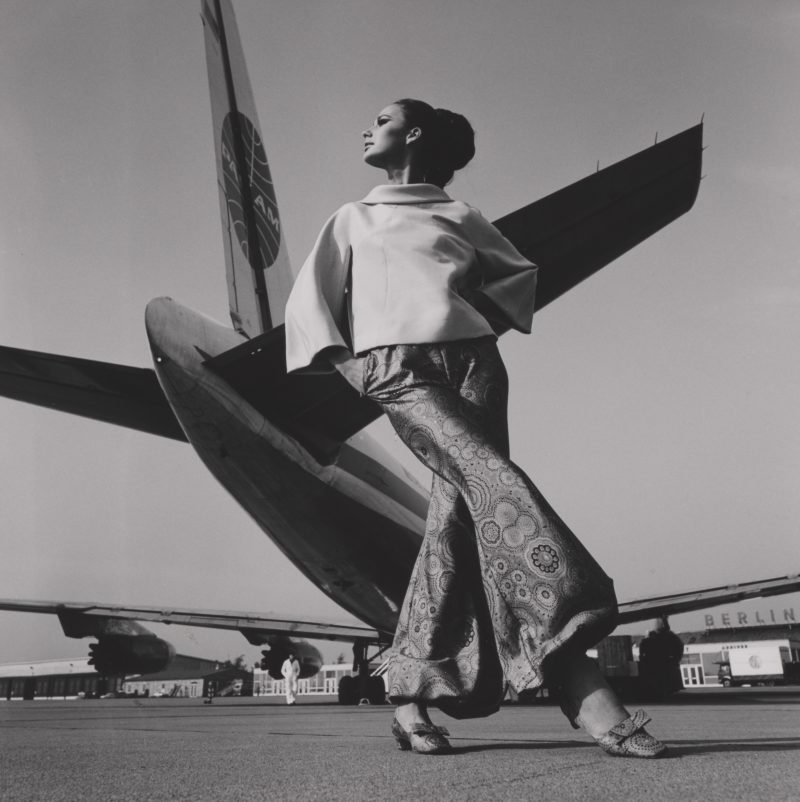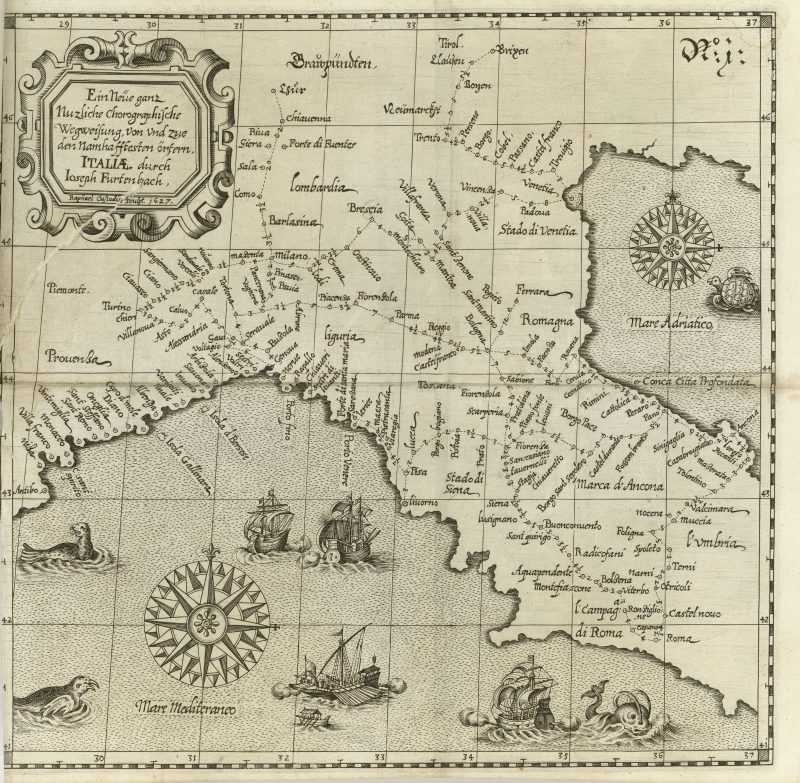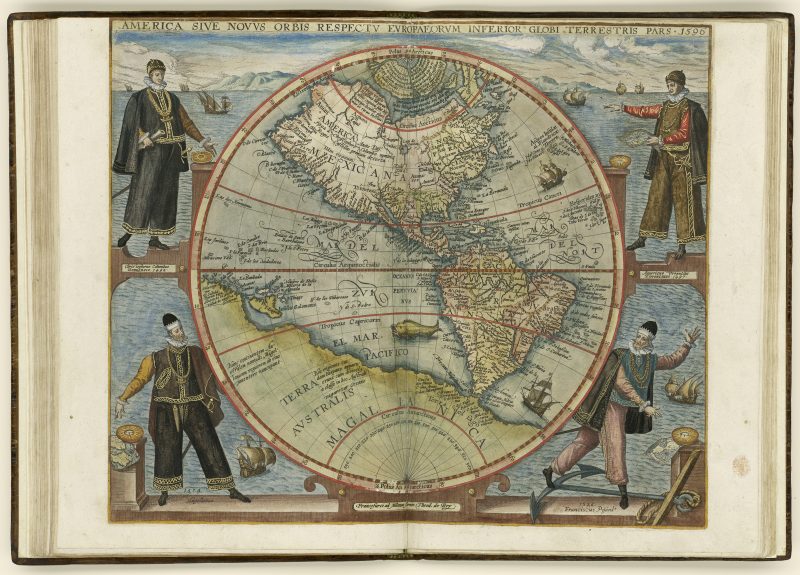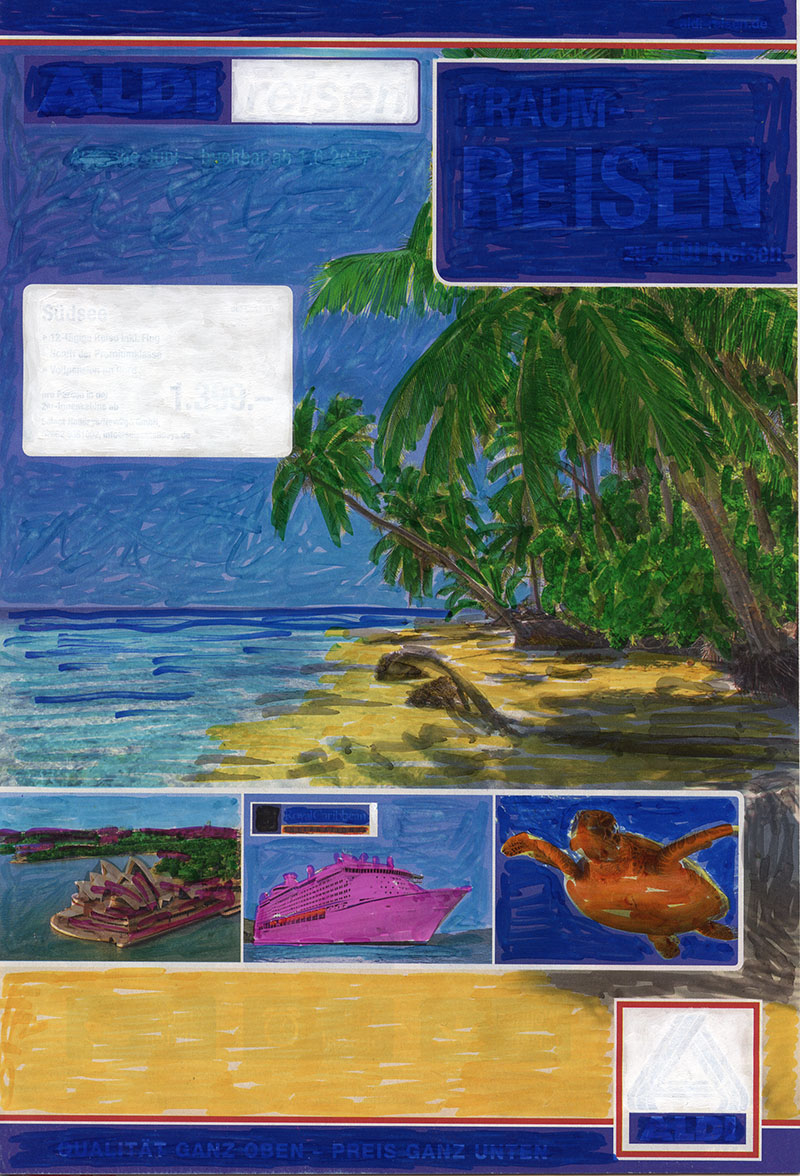Article by Isabelle Hore-Thorburn // Nov. 21, 2018
P is for “Panorama,” from the Greek, “to see everything.” ‘ABC of Travel’ ventures, in both concept and design, to make the history of travel “seen.” As with the panorama, which condenses a 360-degree view into a single shot, the exhibition at the Kunstbibliothek, condenses the history of travel – spanning from pilgrimage handbooks to today’s multi-billion-dollar mass tourism industry – into a single room.

Rico Puhlmann: Frau in Abendensemble mit Pluderhose von Uli Richter vor Pan Am Flugzeug, 1966, photograph, ‘ABC of Travel’ Kunstbibliothek, 2018 // Photo by Rico Puhlmann, Staatliche Museen zu Berlin, Kunstbibliothek
Objects from the art library’s extensive holdings encircle the exhibition space, arranged alphabetically; B is for Bericht (travelogue) as in Jacques de Bourges’ account of his visit to China in 1671; C is for Cartography, signified by Theodor de Bry’s America (1596). The result is an itinerary of travel history that comprises works by fashion photographer Rico Puhlmann, fashion designer Elli Kowalski, and the architect Peter Behrens.
Like the genre of travel writing, the exhibition evades the uglier themes within the history of travel, including but not limited to displacement, colonialism and more recently climate change. Instead the focus of the exhibition is on the aspirational and recreational, and its timeline traces a predominantly European history. After all, it was through travel that colonizers defined their empire. And today tourists define themselves through the act of travel.

Josef Furttenbach, Reise-Landkarte Italien, In: Newes Itinerarium Italiae, Ulm 1627, Buchdruck, ‘ABC of Travel’ Kunstbibliothek, 2018 // photo by Dietmar Katz, courtesy Staatliche Museen zu Berlin, Kunstbibliothek
In the foyer of the exhibition, selected travel literature by artists, illustrators and photographers, sits alongside a rolling screen of travel images from the #abcoftravel competition, where visitors post images of their holiday photos with the first letter of the respective holidays alongside the hashtag. Both of these installations bear consideration. The tone and perspective of travel literature reflect how tourism shapes and is shaped by our impression of the foreign. The books also illustrate how travel functions within the cultural imaginary in a time of mass tourism and online travel booking. Similarly, within the competition images, we see how tourism mediates and proliferates a particular optimism for our lives and worldview.

Theodor de Bry: Americae, 1596, ‘ABC of Travel’ Kunstbibliothek, 2018 // Photo by Dietmar Katz, Courtesy Staatliche Museen zu Berlin, Kunstbibliothek
Atop its own plinth, and somewhat apart from the other travel literature, sits Flavio de Marco’s Stella; a travel guide for an island in the Aegean. Stella is a journey to a “Super-Place” in the Aegean. The island acts as an image-laboratory, the zenith of “simulation as topographic art.” Its landscapes are modeled on works by Rousseau and Klimt, while its infrastructure, airports, heliports and intricate road networks far surpass that of the UAE. The guide comprises outlines of the geological structure, local population and history of the artificial island. What sets it apart from the other travel literature is that Stella does not exist.
As the extraordinary, early travelogues exhibited in ‘ABC of Travel’ reflect, landscapes have historically functioned as a kind of philosophical image for humans to measure and challenge themselves. The visitors’ travel pictures scrolling in the adjacent corner embolden De Marco’s observation that landscapes today perform a more decorative purpose. He suggests that, because of tourism, landscapes no longer function as a way for human beings to challenge themselves and have instead become a kind of amusement park.

Flavio de Marco: Paesaggio (Trentino-Alto Adige), 2011, Collage, Markierstift und Pastell auf Papier, 21×29cm // Courtesy Flavio de Marco
To turn on Instagram or open Facebook on a laptop is to be bombarded with places and landscapes that we will often never see or experience in person. As we resize, minimize and move these images across our screens, we become further removed from the landscapes themselves. Eventually, we are only capable of understanding the image in two dimensions. The paintings that accompany Stella, and that De Marco created for ‘ABC of Travel’, employ omission and masking to address the sensation of being detached– produced, in part, by our visual habits.

Flavio de Marco, Paesaggio (Aldi Traum Reisen), 2018, Acrylic and Permanent marker auf bedrucktem Papier, 29,5×20cm // courtesy Flavio de Marco
Through his paintings–which stylistically perform their own history of painting–De Marco is able to synthesize the particular nature of today’s tourism industry and its relationship to the imagination and wishful thinking. As evidenced in ‘ABC of Travel,’ travel has always functioned within the imagination, and has always been closely tied to our understanding of self and our place in the world. De Marco’s non-place as ultimate tourist destination is thus the logical next step in our relationship to travel and a sagacious complement to the history of travel.
Exhibition Info
KUNSTBIBLIOTHEK
Group Show: ‘ABC of Travel’
Flavio de Marco
Artist Talk: Sunday, Nov. 25; 3pm
Exhibition: Sept. 20, 2018–Jan. 06, 2019
Matthäikirchplatz 6, 10785 Berlin, click here for map



















